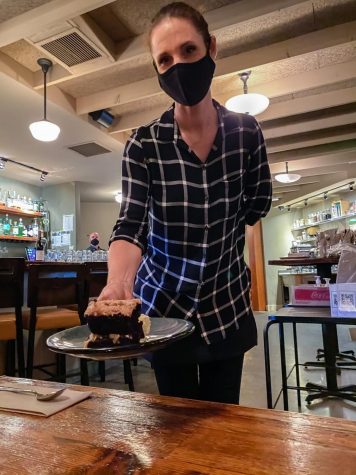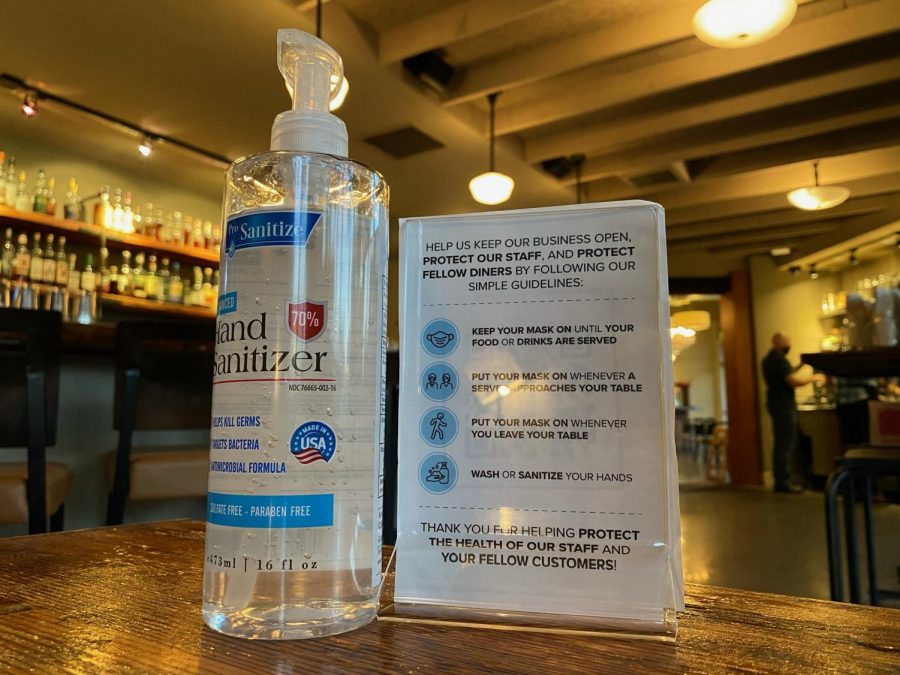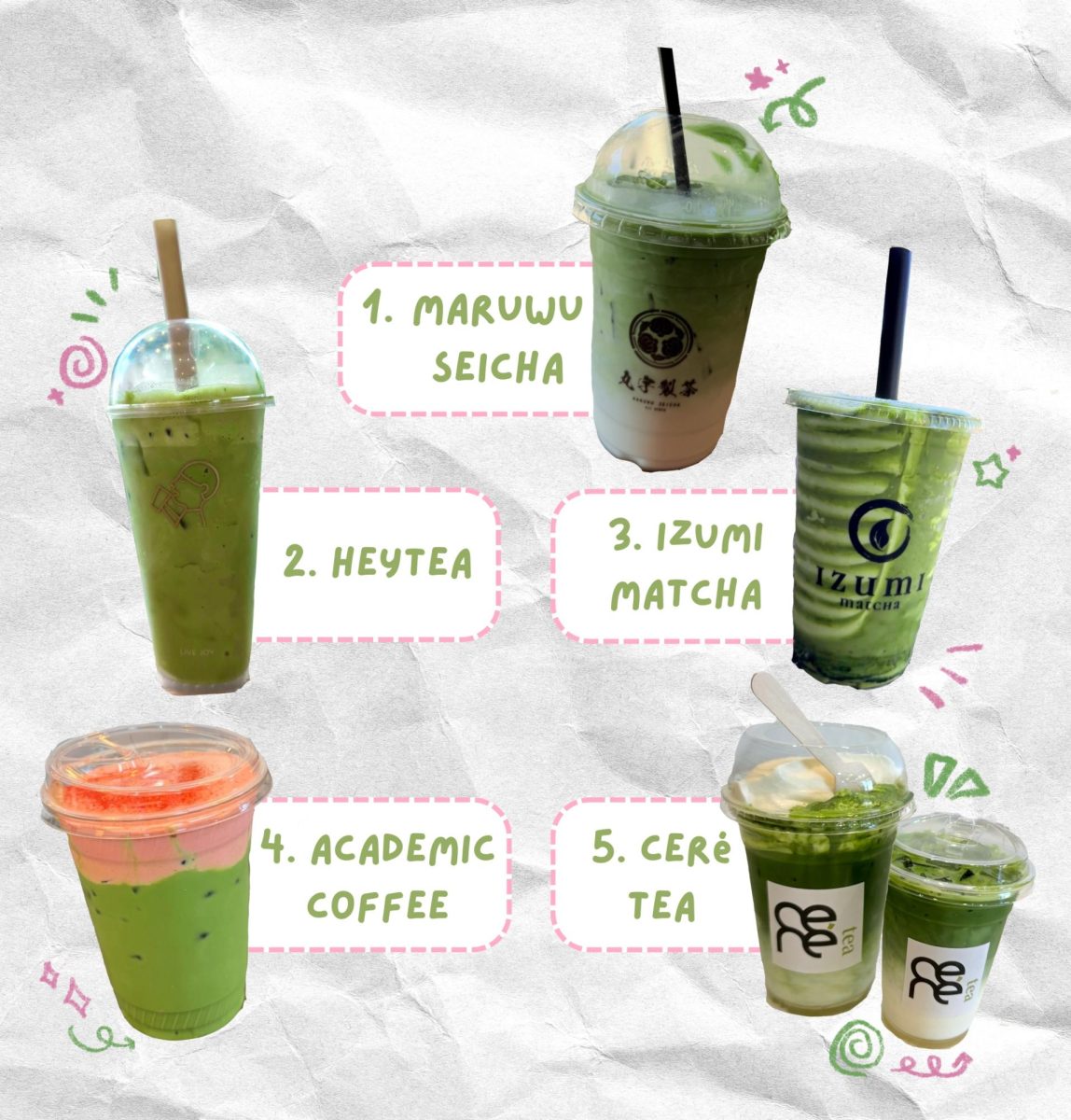Pulse of the People: Local restaurant adapts to pandemic
Staff at “The Table” in Willow Glen work through financial strain, stress and restrictive protocol
Hand sanitizer and COVID-19 guidelines at The Table in San Jose. “I thought that people would be really excited to come and eat here, but even from the get-go you still have people that were going to be unhappy. Unfortunately, sometimes it is taken out on people like essential workers,” manager Alisha Lorenz said.
November 1, 2020
Across the Bay Area, restaurants that previously boasted boisterous crowds of energetic parties conversing over delicious food now stand empty, spare the few individuals dining at the spaced-out tables spilling out of the interior and onto sidewalks.
That certainly has been the case with The Table, an American restaurant in the heart of Willow Glen with a “chef-driven, culinary focus,” as general manager and partner Brian Nicholas said. From their extensive, hand-crafted cocktail program and innovative wines to their classic savory dishes, The Table aims to not only serve delicious food, but to also bring people together over a warm meal.
“[We were a] bustling neighborhood restaurant,” general manager and partner Brian Nicholas said. “We’re also a kind of a meeting point, a place where people can come and see family [and] friends. It’s a part of their neighborhood.”
When Santa Clara county implemented risk mitigation guidelines for restaurants on Apr. 6, The Table transitioned to takeout only, before opening their doors in early June as restrictions permitted outdoor dining.

The Table has also faced financial strain, with the restaurant making only around 40% of last year’s revenue now that fewer people can dine in simultaneously, a trend seen across the nation. According to the National Restaurant Association, total sales in the restaurant and food industry between March and September have fallen short of expectations by nearly $200 billion. Furthermore, customers typically only see superficial results of changes, such as having to dine on sidewalks or waiting longer for their order.
“I thought that people would be really excited to come and eat here, but even from the get-go you still have people that were going to be unhappy. Unfortunately, sometimes it is taken out on people like essential workers,” manager Alisha Lorenz said.
Behind the scenes, tables strategically placed at least 10 feet apart coupled with a shortage of staff have placed a heavier burden on employees, as taking orders, washing hands between bussing tables and sanitizing hot sauces, salt shakers, check presenters and more all accumulate in time.
“It’s all an issue of labor. We would love to have 20 people on and make sure that everything is expedited and everything’s coming out super fast, but the reality is we can’t afford to have so much staff on,” Lorenz said.
With the many changes to protocol since March, Nicholas describes the experience as similar to “re-opening a restaurant a couple of times over.” Some changes, like the shifted focus to take out, created the need to buy transport-friendly containers and napkins, increasing expenses on top of weekly mask and glove purchases for employees.
“Not only is it an extreme cost of investment and of product, but it’s also about time and energy,” Nicholas said. “In this world, we just don’t know what to expect. There’s a lot of mental stress that I think the customers don’t see, and then of course the real cost, dollar-wise.”
Overall, employees at The Table feel more rushed even on top of the usually fast-paced workflow, mainly due to the additional behind-the-scenes work in place to ensure the safety of both the staff and diners.
“[Customers aren’t] seeing everything that’s going into it as far as our staffing or sanitizing [and] all the other protocols [that] are in place, so it’s been like a juggling act like trying to get it all covered,” Lorenz said. “That is definitely one of the areas that we can improve, but it’s just like everyday is a new learning experience and it’s a new way of doing things.”


















![“[Building nerf blasters] became this outlet of creativity for me that hasn't been matched by anything else. The process [of] making a build complete to your desire is such a painstakingly difficult process, but I've had to learn from [the skills needed from] soldering to proper painting. There's so many different options for everything, if you think about it, it exists. The best part is [that] if it doesn't exist, you can build it yourself," Ishaan Parate said.](https://harkeraquila.com/wp-content/uploads/2022/08/DSC_8149-900x604.jpg)




![“When I came into high school, I was ready to be a follower. But DECA was a game changer for me. It helped me overcome my fear of public speaking, and it's played such a major role in who I've become today. To be able to successfully lead a chapter of 150 students, an officer team and be one of the upperclassmen I once really admired is something I'm [really] proud of,” Anvitha Tummala ('21) said.](https://harkeraquila.com/wp-content/uploads/2021/07/Screen-Shot-2021-07-25-at-9.50.05-AM-900x594.png)







![“I think getting up in the morning and having a sense of purpose [is exciting]. I think without a certain amount of drive, life is kind of obsolete and mundane, and I think having that every single day is what makes each day unique and kind of makes life exciting,” Neymika Jain (12) said.](https://harkeraquila.com/wp-content/uploads/2017/06/Screen-Shot-2017-06-03-at-4.54.16-PM.png)








![“My slogan is ‘slow feet, don’t eat, and I’m hungry.’ You need to run fast to get where you are–you aren't going to get those championships if you aren't fast,” Angel Cervantes (12) said. “I want to do well in school on my tests and in track and win championships for my team. I live by that, [and] I can do that anywhere: in the classroom or on the field.”](https://harkeraquila.com/wp-content/uploads/2018/06/DSC5146-900x601.jpg)
![“[Volleyball has] taught me how to fall correctly, and another thing it taught is that you don’t have to be the best at something to be good at it. If you just hit the ball in a smart way, then it still scores points and you’re good at it. You could be a background player and still make a much bigger impact on the team than you would think,” Anya Gert (’20) said.](https://harkeraquila.com/wp-content/uploads/2020/06/AnnaGert_JinTuan_HoHPhotoEdited-600x900.jpeg)

![“I'm not nearly there yet, but [my confidence has] definitely been getting better since I was pretty shy and timid coming into Harker my freshman year. I know that there's a lot of people that are really confident in what they do, and I really admire them. Everyone's so driven and that has really pushed me to kind of try to find my own place in high school and be more confident,” Alyssa Huang (’20) said.](https://harkeraquila.com/wp-content/uploads/2020/06/AlyssaHuang_EmilyChen_HoHPhoto-900x749.jpeg)















